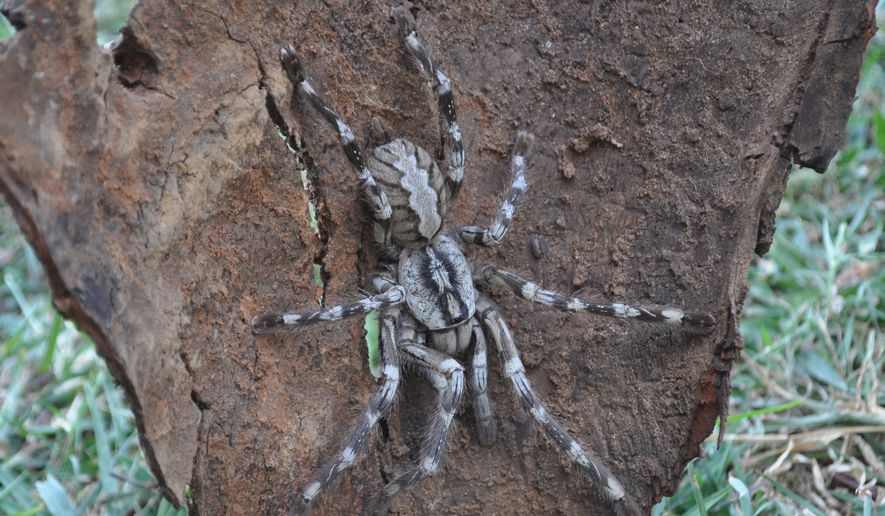The decision to list five Sri Lanka tarantulas as endangered drew cheers from wildlife advocates even as U.S. collectors worried that the regulatory web will actually reduce the number of captive-bred spiders by discouraging breeding.
The Fish and Wildlife Service posted its final rule Tuesday granting Endangered Species Act protection to the five vividly colored tarantulas, among the largest in the world, whose population is declining in the wild as a result of habitat loss.
“We’re thrilled that these beautiful spiders, imperiled by human greed, now have additional protections to help them survive,” said Taylor Jones, WildEarth Guardians endangered species advocate. “We hope these protections encourage conservation and raise awareness about the plight of these species in the wild and the perils of the exotic pet trade.”
Less thrilled was Phil Goss, president of the U.S. Association of Reptile Keepers, who said the federal designation will make it more difficult for tarantula lovers to breed, trade and sell the hairy arachnids.
Under federal law, endangered species may not be sold or transported across state lines without a permit under the captive-bred wildlife registration program, even if they were bred in America.
“Obviously interstate trade of the animals that are bred in the U.S. is going to come to a halt because people aren’t going to be able to get permits,” said Mr. Goss. “It’s expensive—you’re talking about a $200 permit that both parties have to have, both the seller and the buyer, and these animals don’t cost anywhere near $200.”
Even enthusiasts willing to pay the fee face an uphill climb. In his experience, said Mr. Goss, entities other than zoos and aquariums rarely qualify for captive-bred permits.
“Responsible people aren’t going to break the law, so there are going to be less of these animals being bred,” Mr. Goss predicted. “Which some people are okay with, but there’s an argument that even if these animals aren’t going back in the wild, at least that’s a way to preserve the species.”
In its rule, the agency noted that the designation will not stop U.S. hobbyists from owning and breeding the five tarantula species, as long as they were legally obtained, but any sales and trades must be conducted within the same state.
That restriction could wind up depressing the captive population. In the relatively small cocoon of tarantula fandom, breeders often seek out their counterparts in other states, both to expand their pool of potential buyers and avoid inbreeding.
“Whereas before, someone in California could increase their genealogy by getting an animal from the East Coast, now that person won’t be able to do that, so you create a genetic bottleneck,” Mr. Goss said. “The more diverse the genetics, usually the better off they’re going to be.”
Under the Endangered Species Act, the Fish and Wildlife Service said it cannot make exceptions for captive-bred tarantulas.
The prohibitions “apply to all members of each of these species, whether captive or wild … The Act also does not allow for captive-bred specimen of these listed species to be assigned separate legal status from their wild counterparts,” said the agency in its rule on the Federal Register.
In addition, captive-bred spiders “hold limited conservation value to the species in the wild because they are not genetically managed for conservation purposes,” said the rule.
WildEarth Guardians, which petitioned in 2010 for 11 tarantulas to be listed, acknowledged the benefit of private breeding, saying that captive-bred spiders “meet much of the trade demand, but even modest amounts of collection from the wild can negatively impact a small and shrinking population.”
The spiders, part of the genus Poecilotheria, may look large and scary, but they’re nocturnal couch potatoes that stick close to their homes in tree crevices and holes, avoid bright light, and wait for their prey to wander past.
At the same time, their venomous bite produces painful muscle cramps in humans, which may be why they are “usually killed when encountered” by people in Sri Lanka, according to the agency.
The greatest threat to the tarantula is loss and degradation of habitat brought about by the deforestation of the developing island nation, where they are already categorized as “endangered or critically endangered.”
“Sri Lanka lost most of its forest cover over the past several decades to illicit timber harvesting, forest fires, destructive mining, and clearing for development and agriculture,” said WildEarth Guardians. “As habitat disappears and population shrink, collection becomes a greater threat to the species.”
The listing, which goes into effect Aug. 30, prompted hundreds of comments Tuesday from worried owner and breeders on tarantula discussion platforms.
“Laws or not I’ll continue to breed and keep these species where they are safe from habitat destruction,” said Kelly Fornez, owner of KF Invertebrates, on Facebook. “Even if I don’t make a dime the thought of preserving a species for later years to see and enjoy makes it all the more worth breeding.”
• Valerie Richardson can be reached at vrichardson@washingtontimes.com.




Please read our comment policy before commenting.